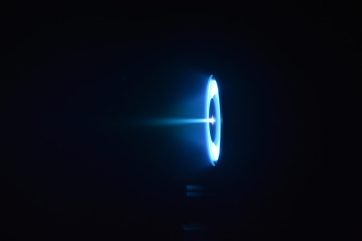
The US Space Force (USSF) is providing $35m to a national research team led by the University of Michigan (UM) to support the newly formed Space Power & Propulsion for Agility, Responsiveness & Resilience (SPAR) Institute. The aim is to bring fast chemical rockets together with efficient electric propulsion powered by a nuclear microreactor. SPAR involves eight universities and 14 industry partners and advisers.
“The Space Force is tasked with securing America’s interests in, from and to space,” said Joshua Carlson, the Space Force programme manager for this effort. “We’re very pleased to work with University of Michigan, and their partners, just like we are for all our other efforts under the USSF University Consortium, as we seek to maintain the Space Force’s edge in great power competition.”
“We are very grateful to the U.S. Space Force and Air Force Research Laboratory for this opportunity. We’re excited to get started on this work with this exceptional national team,” said Benjamin Jorns, UM Associate Professor of Aerospace Engineering and SPAR Institute Director.
Currently spacecraft propulsion relies either on chemical rockets or electric propulsion powered by solar panels. However, while chemical rockets provide a lot of thrust, they burn through fuel quickly. Electric propulsion, on the other hand, is slow and cumbersome but fuel-efficient.
Electric propulsion could be much faster as shown by a 100-kilowatt Hall thruster built at UM. The problem is finding the power to run such thrusters. Jorns, that the space station generates about 100 kilowatts of power, but the solar arrays are the size of a couple of football fields. This is too large for some of the high-power applications that are of interest to the Space Force.
While chemical rockets need fuel to burn, electric propulsion needs propellant to accelerate. Both generate thrust by shooting out material opposite to the direction of travel. Electric thrusters strip electrons from the propellant atoms, turning them into ions, and use electric fields to accelerate them to extremely high speeds. To simplify refuelling, the team aims to demonstrate fuels that can be used to drive the chemical rocket, but which are also an effective propellant for electric propulsion. The Alec D Gallimore Large Vacuum Test Facility at UM tests electric propulsion devices in space-like conditions.
Each piece of the prospective system, and the way the pieces connect, contain interesting problems for the team of researchers. The subteams building devices combine academic and small business partners to pave the way for commercial manufacturing. To develop faster, efficient electric propulsion through the new project, one subteam is developing a concept for a nuclear microreactor. Others will build technologies to turn the heat from a microreactor into usable electricity, and electric engines to turn the electricity into thrust. The propulsion system design includes a chemical rocket for quick manoeuvres.
Collaborators at Ultra Safe Nuclear Corp. will design a new lightweight microreactor while engineers at UM will build a heat source that can mimic its output to test the other components of the power and propulsion system.
Two teams will explore how to extract the thermal energy as electricity. UM and Spark Thermionics will investigate thermionic emission cells, which take advantage of the difference between the heat of the reactor and the cold of space to help drive an electrical current. Another UM team will pair with Antora Energy to implement thermal photovoltaics, like solar cells that turn heat into electricity.
Cornell University, Advanced Cooling Technologies and Ultramet will design lightweight panels that can extract waste heat and radiate it out into space, as the reactor will produce more energy than either conversion approach can realistically use. The University of Wisconsin, UM and Cislunar Industries will design a power processing module that will convert the electricity extracted from the microreactor so that it can meet the high-power demands of the electric engine.
Subteams will explore three different styles of electric propulsion: the Hall thruster (Jorns’ team at UM), the applied-field magnetoplasmadynamic thruster (Princeton University and Champaign Urbana Aerospace) and the electron cyclotron resonance thruster (University of Washington and NuWaves Inc).
Any of these thrusters will rely on a module that turns the propellant into a gas, developed by Western Michigan University and Champaign Urbana Aerospace, and a cathode to prevent the spacecraft from accumulating an electric charge by neutralising the propellant, developed by Colorado State University.
A new concept for a chemical rocket will be developed by UM and Pennsylvania State University. Benchmark Space Systems will provide an already developed commercial system for a proof-of-concept test. The project will be supported with computer modelling and experimental diagnostics developed by U-M, Cornell, Colorado State and the University of Colorado. Analytical Mechanics Associates will assess the full system. Northrop Grumman, Lockheed Martin, Westinghouse and Aerospace Corp comprise the advisory board.
By combining nuclear microreactors and electric propulsion, the project promises to deliver significant improvements in the ability to manoeuvre spacecraft efficiently and quickly in space.






